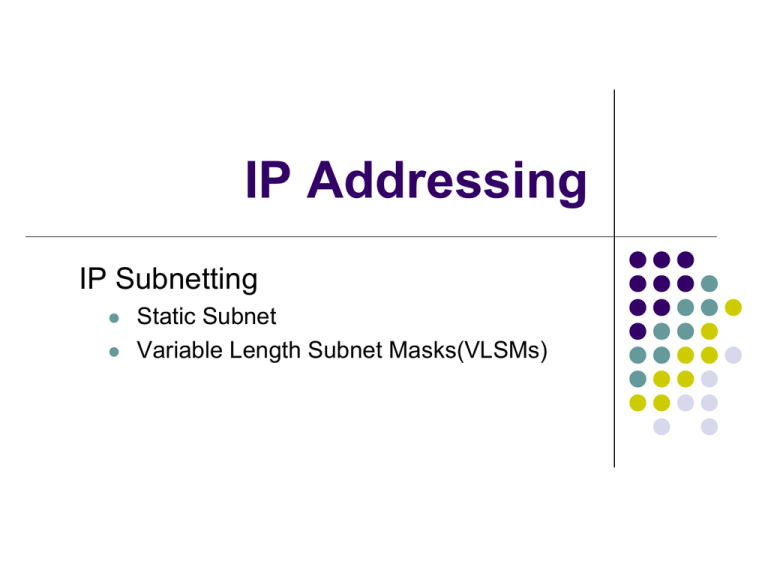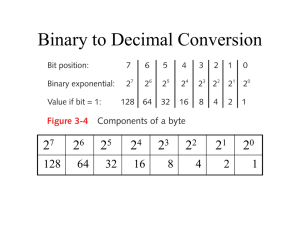
IP Addressing
IP Subnetting
Static Subnet
Variable Length Subnet Masks(VLSMs)
The Hierarchical IP Addressing
Scheme
IP address consists of 32 bits of information.
You can depict an IP address using one of three
methods:
Dotted-decimal, as in 172.16.30.56
Binary, as in 10101100.00010000.00011110.00111000
Hexadecimal, as in AC.10.1E.38
4/6/2015
OIT,RMUTT.
2
4/6/2015
OIT,RMUTT.
3
4/6/2015
OIT,RMUTT.
4
Network Addressing
Network Address Range: Class A
Network Address Range: Class B
00000000 = 0
01111111 = 127
10000000 = 128
10111111 = 191
Network Address Range: Class C
11000000 = 192
11011111 = 223
4/6/2015
OIT,RMUTT.
5
Network Address Ranges: Classes D and E
The addresses between 224 and 255 are
reserved for Class D and E networks. Class
D (224–239) is used for multicast
addresses and Class E (240–255) for
scientific purposes,
4/6/2015
OIT,RMUTT.
6
Summary of the three classes of networks
4/6/2015
OIT,RMUTT.
7
4/6/2015
OIT,RMUTT.
8
4/6/2015
OIT,RMUTT.
9
4/6/2015
OIT,RMUTT.
10
Class A Addresses
network.node.node.node
4/6/2015
For example, in the IP address 49.22.102.70, the 49 is the
network address, and 22.102.70 is the node address.
the network address of all 0s (0000 0000) is reserved to
designate the default route
Additionally, the address 127, which is reserved for
diagnostics, can’t be used either,
you can really only use the numbers 1 to 126 to designate
Class A network addresses. This
OIT,RMUTT.
11
Class B Addresses
network.network.node.node
For example, in the IP address 172.16.30.56, the
network address is 172.16, and the node address is
30.56.
4/6/2015
OIT,RMUTT.
12
Class C Addresses
network.network.network.node
4/6/2015
example IP address 192.168.100.102, the
network address is 192.168.100, and the node
address is 102.
OIT,RMUTT.
13
Private IP Addresses
These addresses can be used on a private network,
but they’re not routable through the Internet.
4/6/2015
OIT,RMUTT.
14
IP Subnetting
4/6/2015
© 2004 Cisco Systems, Inc. All rights reserved.
OIT,RMUTT.
21
ICND v2.2—3-21
4/6/2015
OIT,RMUTT.
22
4/6/2015
OIT,RMUTT.
23
4/6/2015
OIT,RMUTT.
24
4/6/2015
OIT,RMUTT.
25
4/6/2015
OIT,RMUTT.
26
4/6/2015
OIT,RMUTT.
27
4/6/2015
OIT,RMUTT.
28
4/6/2015
OIT,RMUTT.
29
4/6/2015
OIT,RMUTT.
30
4/6/2015
OIT,RMUTT.
31
4/6/2015
OIT,RMUTT.
32
4/6/2015
OIT,RMUTT.
33
4/6/2015
OIT,RMUTT.
34
CIDR -- Classless InterDomain
Routing
192.60.128.0 (11000000.00111100.10000000.00000000) Class C subnet address
192.60.129.0 (11000000.00111100.10000001.00000000) Class C subnet address
192.60.130.0 (11000000.00111100.10000010.00000000) Class C subnet address
192.60.131.0 (11000000.00111100.10000011.00000000) Class C subnet address
-------------------------------------------------------192.60.128.0 (11000000.00111100.10000000.00000000) Supernetted Subnet address
255.255.252.0 (11111111.11111111.11111100.00000000) Subnet Mask
192.60.131.255 (11000000.00111100.10000011.11111111) Broadcast address
In this example, the subnet 192.60.128.0 includes all the addresses from
192.60.128.0 to 192.60.131.255. As you can see in the binary
representation of the subnet mask, the Network portion of the address
is 22 bits long, and the host portion is 10 bits long.
4/6/2015
OIT,RMUTT.
35
CIDR(1)
Under CIDR, the subnet mask notation is reduced to
a simplified shorthand. Instead of spelling out the bits
of the subnet mask, it is simply listed as the number
of 1s bits that start the mask. In the above example,
instead of writing the address and subnet mask as
192.60.128.0, Subnet Mask 255.255.252.0
the network address would be written simply as:
192.60.128.0/22
4/6/2015
OIT,RMUTT.
36
CIDR(2)
The use of a CIDR notated address is the
same as for a Classful address. Classful
addresses can easily be written in CIDR
notation (Class A = /8, Class B = /16, and Class
C = /24)
Reference http://www.sluug.org/resources/cidr.html
4/6/2015
OIT,RMUTT.
37
Variable Length Subnet
Masks (VLSMs)
4/6/2015
© 2004 Cisco Systems, Inc. All rights reserved.
OIT,RMUTT.
38
ICND v2.2—3-38
What Is a Variable-Length
Subnet Mask?
4/6/2015
Subnet 172.16.14.0/24 is divided into smaller subnets
Subnet with one mask (/27)
Then further subnet one of the unused /27 subnets into
multiple /30 subnets OIT,RMUTT.
39
Calculating VLSMs
4/6/2015
OIT,RMUTT.
40
A Working VLSM Example
4/6/2015
OIT,RMUTT.
41
What Is Route Summarization?
4/6/2015
Routing protocols can summarize addresses of several
networks into one address.
OIT,RMUTT.
42
Summarizing Within an Octet
4/6/2015
OIT,RMUTT.
43
Summarizing Addresses in a
VLSM-Designed Network
4/6/2015
OIT,RMUTT.
44
Implementation Considerations
• Multiple IP addresses must have the same
highest-order bits.
• Routing decisions are made based on the
entire address.
• Routing protocols must carry the prefix
(subnet mask) length.
4/6/2015
OIT,RMUTT.
45
Route Summarization
Operation in Cisco Routers
192.16.5.33
192.16.5.32
192.16.5.0
192.16.0.0
0.0.0.0
4/6/2015
/32
/27
/24
/16
/0
Host
Subnet
Network
Block of Networks
Default
Supports host-specific routes, blocks of networks,
and default routes
Routers use longest match
OIT,RMUTT.
46
Summarizing Routes in a Discontiguous Network
4/6/2015
RIPv1 and IGRP do not advertise subnets, and therefore
cannot support discontiguous subnets.
OSPF, EIGRP, and RIPv2 can advertise subnets, and
therefore can support discontiguous subnets.
OIT,RMUTT.
47
4/6/2015
OIT,RMUTT.
48











